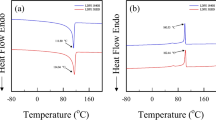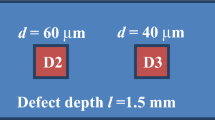Abstract
The objective of this study was to demonstrate the feasibility of upgrading old and tedious approaches of obtaining materials parameters to a computerized process in an affordable, fast and technically efficient manner. The formability and instability of plastic flow in cold-rolled 70/30 cartridge brass in the form of localized deformation is examined using a digital-image-processing technique, allowing for a detailed description of the evolution of the nonuniform deformation pattern in the post-localization regime and making it possible to characterize the localized macroscopic shear bands. Computer interfacing was carried out and a powerful and an efficient package of software was developed for monitoring and managing the DIP system and for analyzing material flow during a uniaxial tension stretching.
Similar content being viewed by others
Abbreviations
- a :
-
half width of root of neck
- [B]:
-
strain-displacement matrix
- F T :
-
correction factor
- m :
-
strain-rate sensitivity
- n :
-
strain-hardening exponent
- r :
-
radius of curvature of diffused neck
- R :
-
anisotropy ratio
- X :
-
stress ratio
- Z i :
-
critical subtangent
- α:
-
strain-rate localization parameter
- ΔU :
-
incremental displacement vector
- Δε:
-
strain vector
- ɛ i :
-
critical effective strain
- ɛ x :
-
axial strain component
- \(\bar \in \) :
-
effective strain
- \(\dot \bar \in \) :
-
effective strain rate
- \(\underset{\raise0.3em\hbox{$\smash{\scriptscriptstyle-}$}}{\rho } \) :
-
strain-increment ratio
- σ:
-
effective stress
- σ y, σy :
-
normal stress components
References
Dieter, G.E., Mechanical Metallurgy, McGraw-Hill Book Company, New York, 651 (1986).
Backofen, W.A., Deformation Processing, Addison Wesley Publishing Company, New York, 204 (1972).
Hill, R., “Acceleration Waves in Solids,” J. Mech. Phys. Solids,10 (1), (1962).
Hill, R. andHutchinson, J.W., “Bifurcation Phenomena in the Plane Tension Test,”J. Mech. Phys. Solids,23,239 (1975).
Chu, T.C., Ranson, W.F., Sutton, M.A. andPeters, W.H., “Applications of Digital-Image-Correlation Techniques to Experimental Mechanics,”Experimental Mechanics,25 (3),232 (1985).
Hamilton, C.H., “Forming of Superplastic Metals,” Met. Soc. of AIME, 232 (1978).
Conrad, H., Demiri, M.Y. and Bhatt, D., “Effects of Material Parameters Including Strain Rate Sensitivity of the Flow Stress on the Stretch-Formability of Sheet Metals,” Met. Soc. of AIME, 208 (1978).
Bayoumi, A.E. and Conrad, H., “Effect of Material Parameters on Stretch Formability of Uniaxial Tension in 3003-0 Al Alloy,” NAMRC XIII, 266 (1985).
Wagoner, R.H. andWang, N.M., “An Experimental and Analytical Investigation of In-plane Deformation of 2036-I4 Aluminum Sheet,”Int. J. Mech. Soc.,21,255 (1979).
Bayoumi, A.E., Frank, H., Hewett, D. andSheldon, G., “A Computer-Aided Application of Stretch Forming in Uniaxial Tension,”Trans. NAMRC,86,379 (1986).
Ragab, A.R., Metawalli, S.M. and Reuda, J., “Preliminary Assessment of Image Processing Application to Large Deformation Measurement,” Pergamon Press, 32 (1986).
Ragab, A.R., Metawalli, S.M., Kamel, A.H. andSaheb, A., “Determination of Plastic Stress-Strain Behavior by Digital-Image-Processing,”Experimental Mechanics,25,414 (1987).
Arce, G.R. andMcloughlin, M.P., “Theoretical Analysis of the Max/Median Filter,”IEEE Trans.,ASSP-35 (1),60 (1987).
Roberts, L.G., “Machine Perception of Three-dimensional Solids,”Optical and Electro-Optical Information Processing, ed. J.T. Tippet, MIT Press, Cambridge, MA (1965).
Rockey, K.C., Evans, H.R., Griffith, D.W. andNethercot, D.A., The Finite Element Method, John Wiley, New York, 83 (1975).
Keeler, S.P. andBakofen, W.A., “Plastic Instability and Fracture in Sheets Stretched Over Rigid Punches,”Trans. ASME,56,25 (1963).
Swift, H.W., “Plastic Instability Under Plane Stress,”J.Mech. Phys. Solids,1,1 (1952).
Bridgeman, P.W., “The Stress Distribution at the Neck of a Tension Specimen,”Trans. ASM,42,53 (1944).
Hart, E.W., “Theory of the Tensile Test,”Act. Met.,15,351 (1967).
Joshi, R.B., Bayoumi, A.E. andZbib, H.M., “Evaluation of Macroscopic Shear Banding Using a Digital Image Processing Technique,”Scripts Metal.,24,1747 (1990).
Aifantis, E.C., “The Role of Softening and Higher Order Gradients in the Localization of Deformation and Damage,” Proc. Int. Conf. Appl. Mech., ed. Z. Zhemin, Pergamon Press (1989).
Author information
Authors and Affiliations
Rights and permissions
About this article
Cite this article
Joshi, R.B., Bayoumi, A.E. & Zbib, H.M. The use of digital processing in studying stretch-forming sheet metal. Experimental Mechanics 32, 117–123 (1992). https://doi.org/10.1007/BF02324722
Received:
Revised:
Issue Date:
DOI: https://doi.org/10.1007/BF02324722




